Taipei Metro C301
The Taipei Metro C301 is the first generation of an electric multiple unit train car, and was the first of its kind to be used on the heavy-capacity lines of the Taipei Rapid Transit System. Built by Kawasaki Heavy Industries and Union Rail Car Partnership and it was introduced in 1997, and it currently serves the Tamsui-Xinyi line.
| Taipei Metro C301 | |
|---|---|
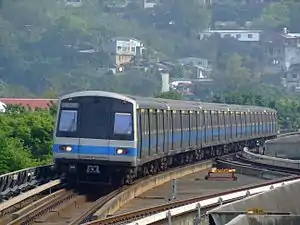 A Taipei Metro C301 train on the Tamsui–Xinyi line. | |
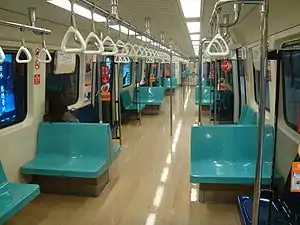 Interior design of the (unrefurbished) motor car of a C301 train | |
| In service | 28 March 1997–present |
| Manufacturer | Kawasaki Heavy Industries and Union Rail Car Partnership |
| Built at | Kobe, Hyōgo, Japan; Yonkers, New York, USA |
| Constructed | 1992–1994 |
| Refurbished | 2011–2019 |
| Number built | 132 vehicles (22 sets) |
| Formation | A pair of 3–car sets per trainset DM1-T-M2-M2-T-DM1 |
| Fleet numbers | 001/002–043/044 |
| Capacity | 1914 passengers |
| Operator(s) | Taipei Rapid Transit Corporation |
| Depot(s) | Beitou |
| Line(s) served | |
| Specifications | |
| Car body construction | Stainless Steel |
| Car length | 23.5 m (77 ft) |
| Width | 3.2 m (10 ft) |
| Height | 3.6 m (12 ft) |
| Maximum speed | Design: 90 km/h (56 mph) Service: 80 km/h (50 mph) |
| Weight | 39.5 t (DM1/M2) 34 t (T) |
| Traction system | Original: GTO-VVVF (Westinghouse Electric) Current: IGBT-VVVF (Bombardier MITRAC 1000) |
| Traction motors | 145 kW three phase synchronous motors[1] |
| Power output | 1160 kW[1] |
| Electric system(s) | 750 V DC Third rail |
| UIC classification | Bo'Bo' + 2'2' + Bo'Bo' + Bo'Bo' + 2'2' + Bo'Bo' |
| Bogies | Bolsterless bogies |
| Braking system(s) | Regenerative and disc brakes[1] |
| Safety system(s) | ATC (ATO), ATS |
| Coupling system | Tomlinson |
| Track gauge | 1,435 mm (4 ft 8 1⁄2 in) standard gauge |
History
Following the approval of the Taipei Mass Rapid Transit Project by the Executive Yuan in 1986, a contract of 800 metro cars worth $1 billion - 200 of which were for the new Tamsui-Xindian line and were worth $200 million - was called. This order was believed to receive multiple bids from many companies; two American bidders that stood out were the Union Rail Car Partnership (URC) consisting of Kawasaki Rail Car, Nissho Iwai American and its subsidiary North American Transit Corporation and the United States Taiwan Transit Group consisting of General Electric, Westinghouse Electric, General Railway Signal, Pullman and Westinghouse Air Brake Company. The latter, which was formed solely to bid for this project, was seeking to supply both the rolling stock and signalling systems to Taipei and proposed to build the trains at Pullman's plant in Barre, Vermont. On the other hand, URC, a joint venture of two wholly owned American subsidiaries of Japanese companies, promised that all subsidiary contracting work be done through American source subcontractors, and all construction work be done in the United States, citing the creation of 300 jobs at Kawasaki's Yonkers rail car plant and at least 500 other jobs in the local economy.[2] Eventually, the URC prevailed and was awarded a contract worth US$170 million to build 132 cars.[3]
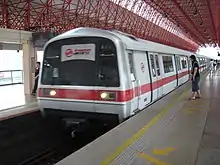
In the order of the first 132 cars, Kawasaki built the carbody shells in its main rolling stock plant at Hyōgo, Japan and subsequently shipped them to Port Elizabeth, New Jersey. URC performed the final assembly of the trains through assembly of the bogies and installation of brakes, propulsion and air-conditioning systems, along with the seats, vertical poles and other interior equipment into the carbody at the 150,000-square-foot (14,000 m2) Yonkers Plant in New York.[4] The Taiwanese officials having visited Singapore earlier in 1988 to study the city-state's then-newly opened MRT, the trains were built to a very similar design as Singapore's C151 trains, which were built by a consortium of four Japanese rolling stock companies that included Kawasaki.[2]
Despite the promising prospects of the Taipei rolling stock contract for URC, URC was not successful in securing the contract of the next batch of 216 cars; this contract was instead awarded to Siemens of Germany. Reasons cited by Taipei's Department of Rapid Transit Systems (DORTS) for this decision was concern that URC might be just a front for a Japanese company. This became a point of contention in Yonkers, which had a 7.5% unemployment rate in May 1993, as the manufacturing sector in the United States was facing a decline.[4] Although US officials tried to convince DORTS to reverse this decision, it was presumably unsuccessful.
Overview
The C301 is built with stainless steel carbody and is hence unpainted save for a blue stripe running across the train exterior and the DORTS logo. The front profile of the C301, as compared to the later Siemens-built cars, is curved as opposed to being straight. The train uses pneumatically-controlled doors and features a round door opening indicator. To inform passengers of the direction of the train service, LED displays that display the terminus of the train service are also mounted on the side windows.
The undercarriage of the C301 features bolsterless bogies and a VVVF traction control; the latter was originally GTO-VVVF inverters from Westinghouse Electric but they have since been replaced by Bombardier MITRAC IGBT-VVVF inverters.[5] The Westinghouse Electric GTO-VVVF traction system sounded reminiscent of the T1 subway cars' traction system of the TTC subway in Toronto, Canada and the R110A subway cars' traction system of the New York City Subway.
Interior Design
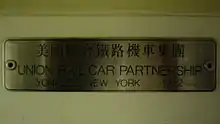
The interior of the C301 contains seats arranged in both linear and latitudinal formations and is made with fiber-reinforced plastic.[5] There are priority seats and wheelchair spaces for those requiring special accommodations. In case of emergencies, fireproofing materials allow the C301 to withstand any fire for up to 45 minutes. Train announcements and next station information are displayed on LED information systems above the passenger doors. The destination and line color are displayed on the exterior of the car. The train also features open gangways to allow passengers to move between cars within a trainset.
A major distinctive feature of the C301 trains is the concealment of the air-conditioning system among the lighting. The handrail configuration of the C301 was also originally different from the later trains prior to refurbishment.[6] The train also initially featured wooden-colour flooring prior to refurbishment.[5]
Deployments
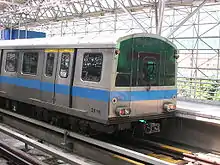
In the initial period of operations, the C301 operated on Tamsui-Xindian and Beitou-Nanshijiao routes via Chiang Kai-shek Memorial Hall and Guting. Following the opening of the new Dongmen station in 2012, the Beitou-Nanshijiao route was amended to become Beitou-Taipower Building route; this route was again modified with the opening of the Xinyi Line and instead terminated at Xiangshan.[7]
With the opening of the Songshan Line in 2014, the Tamsui-Xindian route was withdrawn and the C301 trains are now confined to the Tamsui-Xinyi Line.[7] Trainsets 027/028 and 037/038 performed the final departures on the Tamsui-Xindian route on 14 November 2014.
Train set 013/014 had been previously split and modified to serve as 3-car formations on the Xinbeitou branch line. When new 3-car formation C371 cars were introduced, train set 013/014 was subsequently re-joined and put back into normal service on Tamsui–Xinyi line from 22 July 2006 onward.[6]
Train formation
A complete six-car trainset consists of an identical twin set of one driving motor car (DM1), one trailer car (T) and one intermediate motor car (M2) permanently coupled together. The configuration of a C301 trainset in revenue service is DM1–T–M2–M2–T–DM1.
Each car is assigned its own four-digit serial number, which ranges from x001 to x044.
- The first digit (the 'x' above) indicates the position of the car. Hence, DM1 cars use the number x=1, T cars x=2, and M2 cars x=3
- The other three digits are the identification number of the train the car is part of. A full-length train of six cars consists of two identification numbers, one for the first three cars, and another for the second three. The bigger number is always equal to the smaller number plus one, and the smaller number is always an odd number. For example, a train of six cars would have serial numbers 1001, 2001, 3001, 3002, 2002, and 1002, respectively.
- Taipei Metro names train set numbers such as 01/02, 03/04, etc. instead of 001/002, 003/004, etc. (The numbers on the stickers near the driver's doors are only 2 digits long.)
Refurbishment

From 2011 to 2012, the C301 cars underwent refurbishment, and were fitted with new air-conditioning, surveillance, and fire detection systems. The original wood-style flooring was replaced with mostly white flooring, and the previously red LED in-train information systems were replaced with new LED in-train information systems.[5] The first 11 C301 trains also received new IGBT-VVVF propulsion systems from Bombardier Transportation in 2013.
Train set 013/014 had been previously split and modified to serve as 3-car formations on the Xinbeitou branch line. When new 3-car formation C371 cars were made, train set 013/014 was subsequently re-joined and put back into normal service on Tamsui–Xinyi line. Train set 013/014 is also equipped with IGBT-VVVF inverters.
In 2017, the latter 11 sets are fitted with IGBT-VVVF inverters, effectively retiring all GTO-VVVF inverters.
See also
- Kawasaki Heavy Industries C151 - the design basis of the C301
References
- 蘇, 昭旭 (2014). 台灣鐵路火車百科:台鐵·高鐵·捷運 第三版. Taiwan: 人人出版. ISBN 9789865903404.
- Rail Car Plant In Yonkers Seeks $1 Billion Contract, The New York Times, James Feron, 17 January 1988
- 川崎重工業時代1969年(昭和44年) Archived 2010-03-26 at the Wayback Machine, Kawasaki Heavy Industries, retrieved 6 April 2008 (in Japanese)
- Yonkers Fighting To Save Rail-Car Jobs, The New York Times, Elsa Brenner, 25 July 1993
- "台北捷運車両紹介301型". 2427junction.
- "第五章 捷運列車介紹". fgu.edu.tw.
- "C301型電聯車". bus194625.pixnet.net.